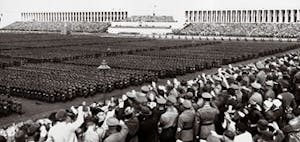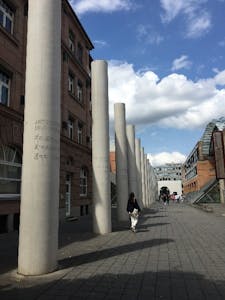Chelsea, our Head of Research, and Hannah, our Learning Assistant, recently discovered that they both love to travel (and drink wine, eat chocolate, and read, amongst other things). Coincidentally, we have visited many historical sites relating to the Third Reich and the Holocaust. Although we have visited several different locations, we shared some similar reactions and remain avidly curious about these controversial and traumatic sites. (Something about us both being female working in Holocaust heritage, eh?)
We decided that it would be compelling to explore our discussions of the history, impact and relevance of these sites into a series of ‘in conversation’ blogs. We hope you enjoy!


Chelsea: So, let’s chat about some of the most obvious and popular destinations in the Third Reich. Nuremberg hosted the Nazi Party’s massive, annual rallies from 1933 onwards. Tell me about Nuremberg. When did you first visit?
Hannah: I first went to Nuremberg in 2016, then again in 2018. On my first visit, although being aware of the city’s Nazi past, I didn’t really explore it – I went to the castle, walked the city walls and explored the beautiful old town. However, when I went in 2018, I wanted to explore the ‘dark side’ of one of my favourite places. I visited the Court where the Nuremberg Trials took place but it was the former Nazi rally grounds that had the biggest impact on me.

Chelsea: Oh yes, the ones depicted in Leni Riefenstahl’s Triumph of the Will. What did it feel like to visit the Nazi Rally Grounds?
Hannah: The first thing that hit me was just how colossal the buildings are! We are all used to big buildings and skyscrapers, but these buildings were so imposing and threatening in a way that I hadn’t experienced before. Of course, they were designed to do that, to show the power and strength of the Nazi regime. I walked around to the Zeppelinfeld, recognisable to so many from the footage and pictures from the Nazi rallies.


I was amazed that you could walk up to it, walk on it even. I climbed up the stairs and I stood at the top, in front of the ornate metal doors, then walked down the steps towards the small balcony and stood on the spot where Hitler stood. I could see for miles from where he would give speeches. When Hitler looked out, he would have only seen people, tens of thousands of supporters, at one point there were upward of 700,000 people there.
As someone who has performed on stage and attended many music festivals, it was easy to imagine the energy that would have consumed those in the audience. They have even used the Zeppelinfeld as a concert venue, Metallica have played there. But the fervour of the crowd at the Nuremberg rallies would have been so electric, and powerful, that it is easy to see how people were swept up in it. And the disbelief that I felt to stand where this all took place – it was a feeling that stayed with me a while.
It wasn’t busy either, there were a handful of other tourists, a group of German students were sat chatting, probably on a break from college and a group of young boys were playing football not far away. Life was continuing in front of this structure that represents one of the darkest moments in humanity, and I found that odd.

Chelsea: It does sound odd. But then, how should such sites be used? What do you think should happen to them?
Hannah: I’ve seen the grounds described as a ‘political Chernobyl’. In many ways, I agree with that. Because at the moment they are falling into disrepair, but they can’t be destroyed as they are listed buildings. But to restore them would cost an incredible amount of money. From my point of view, I think they should be protected for education, and carefully monitored as I imagine they must be a pilgrimage site for neo-Nazis today.
On the other hand, Nuremberg has distanced itself from its Nazi past, in a way that I feel is different to other Germany cities. They have fully acknowledged it, but are now proud to be a ‘City of Peace and Human Rights’ and that is their focus. So I imagine for the people that live there, these rally grounds are an uncomfortable reminder, but physically they are value-less, just somewhere that is part of where they live, meaning that children can play football there and friends meet there. And maybe that reclaiming is a good thing.

Chelsea: Yes! Reclaiming is definitely a very important part of confronting the past. That’s actually how I feel about the Berlin Olympic Stadium. I’ve been to a lot of tourist destinations of the Third Reich and the Holocaust, but the Olympic Stadium was exceptional.
Hannah: Why? How was it exceptional?
Chelsea: I mean, it’s a stadium like many others, right? So you expect to see a huge arena with enormous capacity to hold tens of thousands of people. And the Berlin Stadium had all that too – it’s certainly been ‘reclaimed’ as a sports venue. I paid for a ‘behind the scenes’ tour and saw where the athletes warmed up downstairs, the changing rooms, the press rooms, a prayer room, and even the lounge where rock stars like Beyonce and Jay-Z would relax before a concert. But many tourists failed to notice a few key items, unless they were highlighted by the guide, or unless you were a nerdy historian of the Third Reich.
Hannah: Like what? What did you see?
Chelsea: You notice immediately that unlike other stadiums, there are no advertisements plastered across the building or lining the centre pitch – no Pepsi, no Adidas, no BMW, nothing. Bizarre, right? This is because the Stadium is classified as a historical monument and is solely owned by the State of Berlin. The football club Hertha BSC rents the space but all advertisements must be removed after every event. As a result, Berlin Stadium is visually very different and very clean and the features of the building therefore really stand out.

One of the things I immediately noticed was the lanterns! These were discreetly hidden inside the pillars, but on the outer edge of the building. This means that only attendees would notice their aesthetic uniformity when accessing their seats. We must remember that the Nazis reinvented the entire Olympic narrative into a propaganda feast – in Leni Riefenstahl’s Olympia, we see the sacred fire from ancient Athens being carefully carried by athletes to the Stadium in Berlin. I mean, this symbolic act is still carried out during today’s Olympics. But, having said that, these lanterns mean so much more than just the Olympic torch!

Hannah: How so? How do the lanterns mean more than the Olympic torch?
Chelsea: Fire was used heavily within Nazi propaganda. Bonfires and torchlit parades were used to symbolise the revival of ancient ‘Nordic’ rituals and the national rebirth of the German community. Thousands of Germans would participate in evening parades, where Stormtroopers would gather around large bonfires to recite “Oaths of Fire” before book burnings, or singing Christmas carols, or other rituals. So the fact these lanterns are only visible to attendees – which I discovered from the tour guide were the original lanterns from the 1930s – is a quiet gesture to the broader symbolism of the Reich, and of the Nazis’ belief in revitalising the German nation. And the Olympic Stadium was littered with dozens of these little reminders, which your average tourist never noticed. That’s why I found it so incredible. The Nazis, at least from a propaganda and design perspective, truly thought of everything.

Hannah: It seems like the Nazis really did think of everything. So what was your favourite part of the tour?



Chelsea: The viewing platform for the VIPs! This viewing platform, which you can see jutting out slightly, is the original! It’s where Hitler opened and closed the Olympic ceremonies, and it is also where today’s leaders sit for sporting events, including Germany’s Chancellor, Angela Merkel.
And as I stood there, I imagined I was back in August 1936, at the height of the Berlin Olympics. The stadium at the time seated 74,000 people and nearly 4,000 athletes competed in 129 events. As I stood on this platform, I imagined what it must have felt to feel the energy of an ecstatic nation on the brink of enormous change. And, importantly, what it must have felt like to be Hitler in that moment, holding the entire world’s gaze while standing proudly, and even fiercely, on this platform.

Hitler was murderer, a megalomaniac, a dictator of the worst kind. But in 1936, he hadn’t yet committed his worst crimes. I mean, he was Times’ Man of the Year just two years after the Berlin Olympics. And while I don’t mean to suggest that Hitler had anything but the most malicious intent against his own people (because he truly did), the Berlin Olympics and this platform represented to me a moment suspended in time, when anything could have been possible for 1930s Germany. If it had been a different leader or a different political party, then other choices could have been made during the Olympics that embraced diversity, such as shaking Jesse Owen’s hand, choosing equality over racism, peace over war, and revitalising the German nation into something that wasn’t so fearlessly despotic, divided, and violent.

I remember sighing angrily that anyone as dangerous as Hitler could walk this earth. Eventually I returned to the present moment and sat in Angela Merkel’s favourite seat, off to stage right on the platform. This is where I imagined how incredible and daunting it must now feel, so many years later, to represent the political face of a nation which Hitler once commanded. Regardless of your sentiments towards Merkel, you cannot deny that holding the Chancellorship in such a symbolic environment as the Berlin Olympic Stadium wouldn’t make you dumbstruck.

That’s why this was such a powerful and provocative experience for me. Standing where Hitler stood in an place that oozing National Socialist doctrine and imagining a time before the Holocaust and the Second World War… It’s both upsetting and moving. I recommend that everyone visits.
